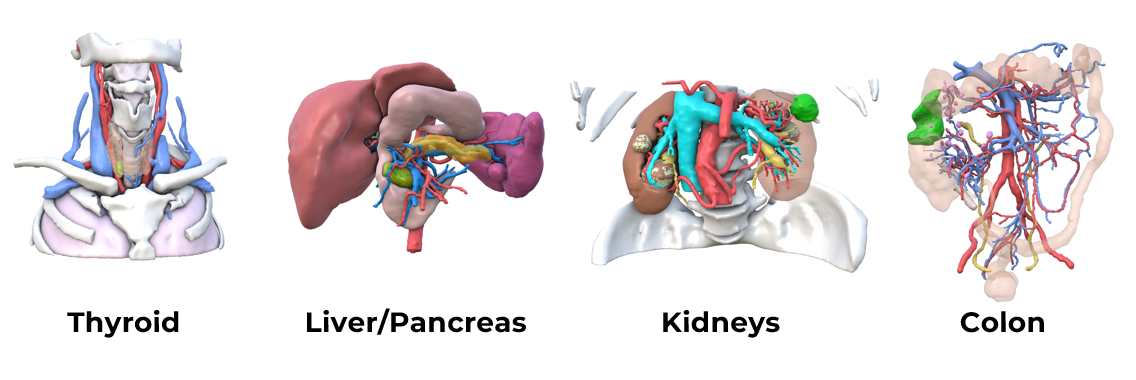
Thanks to Visible Patient 3D modelling, this patient had a curative surgery for his lung cancer
The 3D reconstruction of this patient detected with a new lung cancer enabled a surgery that seemed to be impossible without it.
This patient had already undergone two surgeries. In the first one, a third of his right lung was resected, and in the second half of his left lung was resected. When a new tumor appeared in his right lung, a surgical therapy seemed impossible without removing too much lung. After 3D modelling of his bronchus tree, his pulmonary arteries and his pulmonary veins, a surgery appeared possible thanks to Visible Patient preoperative simulation software. With this digital twin, the invisible became visible. The surgeon was able to cut out a tiny part of the lung containing the tumour, without damaging the rest of the lung.
As a result, this initially inoperable patient was finally operated on and cured.
From a grayscale medical image, MRI or CT scan (for the lungs in particular), Visible Patient software extracts a 3D digital twin in color of each patient’s specific anatomy. This 3D reconstruction is easy to read, enabling the surgeon to see what was invisible on the medical image, and the patient can better understand his or her anatomy as well as the proposed therapy.
Organ anatomy can be compare to a tree
In simple terms, a surgery can be compared to the treatment of a diseased tree. The idea is to cut the branch supplying the diseased part of the tree, in order to preserve as much as possible of the organ. The difficulty lies in knowing which branch to cut, and how much organ volume will remain once the branch has been cut away.
In fact, if you cut a too large part of an organ, there won’t be enough remaining volume to live. This would be called insufficiency (respiratory for the lungs, hepatic for the liver or renal for the kidney). This difficulty is amplified by two others: there is not just one network of branches but several ones, and these networks configuration varies from one patient to another.

The Visible Patient surgical planning software allows to simulate the operation by selecting the branches to be cut. It then automatically estimates the remaining functional volume before the surgery. Thanks to this information and simulation, the surgeon can define the optimal procedure, taking into account the patient’s anatomical specificities.
What was invisible to the human eye becomes visible in 3D and in color, and surgery that seemed impossible become feasible.
The benefits are numerous: shorter operating times, less bleeding, fewer complications. All these benefits, validated by numerous clinical studies, have led the world’s leading experts to conclude that these 3D models are essential prior a lung or a liver surgery.
To understand each patient’s anatomy and detect possible lung cancer, a CT scan is usually performed, showing the vessels after a contrast agent injection. Such injection, although necessary, are a source of inconvenience and sometimes complications. Moreover not all patients can benefit from this injection due to allergy, kidney failure or asthma.
After several years’ research, Visible Patient has succeeded in overcoming this limitation by developing a new software solution based on artificial intelligence, which enables 3D modelling of the bronchus tree, pulmonary arteries and pulmonary veins from CT images, but without injections.
In 2024, the clinical study conducted with Dr. Agathe Seguin at the Institut Mutualiste Montsouris in Paris demonstrated that these injection-free 3D modelling was as efficient than without contrast agent injection, making digital surgery accessible to all patients. Moreover, since patients no longer need to undergo an injection during their CT-scan, this innovation divides X-ray doses by 3 and removes any risk of complications linked to the contrast agent.
These models are now covered by our many private insurance partners, including Harmonie Mutuelle and Santéclair, who have financed communication campaign against lung cancer.
The future of personalized digital surgery for all is on the move.
